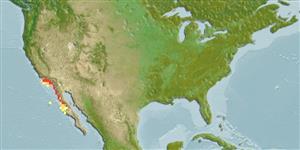>
Perciformes/Zoarcoidei (Eelpouts and pricklebacks) >
Opisthocentridae ("Rearspined fin pricklebacks")
Etymology: Lumpenopsis: Latin, lumpus, an uncouthlooking spiny-finned fish of a leaden-blue colour + Greek, opsis = appearance (Ref. 45335); clitella: From the Latin clitella meaning saddle, in reference to the series of dark, dorsal saddles (Ref. 51122).
Environment: milieu / climate zone / depth range / distribution range
Ecologia
marino demersale; distribuzione batimetrica 54 - 100 m (Ref. 51122). Tropical
Distribuzione
Stati | Aree FAO | Ecosystems | Presenze | Point map | Introduzioni | Faunafri
Eastern Central Pacific: southern California, USA.
Size / Peso / Age
Maturity: Lm ? range ? - ? cm
Max length : 5.3 cm SL maschio/sesso non determinato; (Ref. 51122); 5.5 cm SL (female)
Short description
Chiavi di identificazione | Morfologia | Morfometria
Spine dorsali (totale) : 47 - 48; Raggi dorsali molli (totale) : 0; Spine anali: 1; Raggi anali molli: 30 - 31; Vertebre: 53 - 54. No scales on cheek; 138-145 irregular scale rows along midline; ventralmost 3-6 pectoral fin rays unbranched; eye relatively small (5 times in HL); dorsal sensory pores relatively small (diameter of anteriormost temporal pore, commissural pore and median supratemporal pores less than length of nostril tube); five or six spots along dorsal fin; eight dorsal saddles on body and little pigment below midline (Ref. 51122). Caudal fin rounded (Ref. 51122).
Life cycle and mating behavior
Maturities | Riproduzione | Spawnings | Egg(s) | Fecundities | Larve
Hastings, P.A. and H.J. Walker Jr., 2003. Lumpenopsis clitella: a new species of prickleback (Teleostei: Stichaeidae) from southern California, with comments on Lumpenopsis Soldatov. Copeia 2003(4):803-809. (Ref. 51122)
IUCN Red List Status (Ref. 130435)
Threat to humans
Harmless
Human uses
Strumenti
Special reports
Download XML
Fonti Internet
Estimates based on models
Preferred temperature (Ref.
123201): 7.7 - 10.4, mean 8.8 °C (based on 11 cells).
Phylogenetic diversity index (Ref.
82804): PD
50 = 0.5625 [Uniqueness, from 0.5 = low to 2.0 = high].
Bayesian length-weight: a=0.00102 (0.00046 - 0.00225), b=3.06 (2.88 - 3.24), in cm total length, based on all LWR estimates for this body shape (Ref.
93245).
Trophic level (Ref.
69278): 3.1 ±0.5 se; based on size and trophs of closest relatives
Fishing Vulnerability (Ref.
59153): Low vulnerability (10 of 100).
